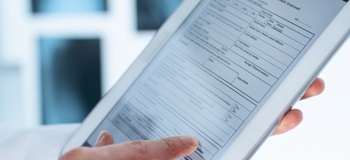
What is CRM in healthcare?
The obvious first question should be “what does CRM mean in healthcare?” and the answer is that healthcare CRM is a customer management system that handles both the front-end care and back-end commercial aspects of modern healthcare.
Health CRM is sometimes condensed to just HRM, but regardless of the name it is designed to handle the three main areas of administration:
- Sales force automation
This is for transactions surrounding pharmaceuticals, medical devices, and laboratory services. - Marketing automation
This is a hybrid part of CRM. It has patient focus for engagement/outreach, but also engages business to business for trade and sales. - Service automation
This is about delivering healthcare services to individuals. This is where patient engagement and patient portals come into play; communication, registration, scheduling etc.
At Access we have talked about patient engagement, how to measure it, and the strategies involved to encourage greater involvement from people in their own care. CRMs must engage with patients. The whole point of a health CRM is to bring together multiple sources of data (demographics, psychographics etc) to help establish patterns and habits that allow for better understanding of patient wants and needs, and to fit clinical interventions and services into the lives and preferences of people so that that truly onboard the advice and prescriptions of clinicians.
Better management of the patient journey via streamlining means a patient experience, so that it’s easier for them to engage. This in turn typically leads to better care outcomes and a reduction in future admissions to healthcare services.
On the business side it’s about keeping accurate records of commercial dealings in sales and stock to ensure proper supply of medicines and materials. A similar task to stock management software, but a step above in that a CRM is to qualify the operations against the needs of the public/patients based on data analytics.

Patient relationship management software
Healthcare CRM solutions can often be referred to as a patient relationship management system. The patient relationship management platform is supporting the patient journey we mentioned above, and through that support information can be shared within a healthcare organisation’s ecosystem of software solutions.
The most obvious instance of patient relationship management software is a CRM patient portal. Through this you can communicate and engage with the individual, be that to update them on the patient journey itself or to provide learning materials and support.
Patient CRM is its own standalone software solution, but in other solutions it’s half of the health CRM process, and the business to business (B2B) side shouldn’t be forgotten about. Maintaining effective business ties and agreements is crucial to healthcare provision. That’s not to say that an organisation cannot pursue two separate solutions – and a patient relationship management system would be helpful – but there must be provision for both sides of the workload.
Benefits of CRM in healthcare
The fact that healthcare organisations use CRMs is testament to the fact they offer benefits to their operations. Below is a quick rundown of what these benefits are.
Improving patient engagement
For public healthcare like the NHS, a health CRM allows for a more personalised approach to outreach. This means using data to see patterns or preferences, and then using that to tailor the messaging put out to individuals to better connect with their wants and needs.
For private healthcare services it also means more referrals. Better engagement shows willingness to hel p and understanding, and that development of being seen as reliable encourages trust, which then leads to either repeat visits from the patient or even the referral of other people.
In both cases your healthcare organisation can handle appointments and other inquiries with an intelligence that pre-determines the pathways they should be assigned to based on their patient record and their request, thus speeding up the communication process.
CRM is a growing industry
Collaboration and integration are driving forces behind the future of healthcare provision. The current goal of the NHS is frontline digitisation (achieved via the Digital Capabilities framework, with the longer term plan of a digital overhaul of the entire system to create on giant integrated network of care.
The growing availability – and capability – of health and care software solutions is making this joined-up care approach possible, and that means a greater-than-ever need for a CRM to help steer the ship. An HRM can optimise communication and data sharing, as well as offer analytics on things like growth opportunities or demographic patterns that can aid strategy.
GrandViewResearch reports that as of 2021, the healthcare CRM market was worth an estimated $14.3 billion, and would grow annually by 8.4%. Their insight suggests that the combined demand for automation/optimisation and data analytics are also driving demand, with patients eager to get ever-faster diagnosis and treatment.
Saving time and resources
Automation is a popular feature in many healthcare software solutions. Some of this may be schedule management, human resources, or calendar management. Whichever area is benefitting, the wider organisation benefits too.
The more a program can do for you, the more time staff – clinical or administrative – have to perform other tasks, and these often involve the patients directly.
Repetitive or convoluted actions are stressful for staff. The lack of intelligence required to perform these tasks reduces the feelings of accomplishment and job satisfaction. This allows people to become jaded, they quit their role, and then the organisation needs new staff to enter the same cycle of work – burnout – quit. Staff retention in healthcare settings is a tricky area, so by onboarding supportive software solutions you can improve the quality of life for staff. This improves their job satisfaction but also their morale, and the morale of the wider organisation as a knock-on effect.
Improving communication
Saving time on work allows for more time to communicate. This could be internally with colleagues, externally with patients or client, but can also include elements such as education.
A good CRM will also allow better communication across the organisation in respect to data sharing.
Ensuring digital compliance
The more technology advances, the more rules and regulations we need to protect the people from unfair or unwarranted intrusion into their lives. Privacy is important.
Patient data needs to be protected with better data management. Cloud storage is a popular approach, as there’s less of an obvious physical location to target, and good CRMs typically utilise this – as well as the usual permission-based security access to specific individuals or departments.
An easier experience
Patients want you to know about them when you talk to them. It’s quite common to speak to a variety of doctors in a practice, or clinicians in a hospital. Not everybody will know the patient from a past meeting, which is where a CRM can connect threads using patient information from an EPR.
The same goes for patient insights. The patient portal is huge for giving the individual access to their own records, medical history, prescriptions, and even contact with their doctor in some solutions. Empowering individuals improves your standing with them, but it also cuts out unnecessary labour on assisting them when an automated process could handle it for you.
Data Analytics
Speaking of automation, it’s common practice to support data analytics with an automated feedback system that contacts patients after an appointment to gauge their feelings about the clinicians, the setting, the treatment… Knowledge is power and in this case it gives healthcare organisations the power to act in areas that require improvement.
Data doesn’t just need patient feedback though. Engagement in general can be measured by the open rates on emails, the visit rates to your website or the patient portal, heat maps of where patients typically go and read on these sites. These insights show strengths and weaknesses, which once identified allow you to build new strategies to improve services.
There’s also the cost element. Return on investment is supremely important to demonstrate for funding bids, especially within the NHS. A healthcare CRM solution can measure ROI from the marketing channels like emails, text messages, social media posting, and patient portal communication. It can also assess things like patient satisfaction and missed appointments, and whether the two are related. Improving these areas and not wasting appointment time is a huge cost-saver.

Best healthcare CRM software
Now you know what healthcare CRM solutions do, we can begin to showcase the best CRM for healthcare. First though, what should you be looking for in a health CRM?
Data is at the heart of everything within a CRM. You can’t perform analytics, forecasting, or segmentation of information without accurate data records. You need to be confident that the data capture performed by your CRM is accurate – both in terms of details taken and being timely.
Beyond this you should also look at reputation, reviews, and promises. Trustpilot is a great indicator of a company’s behaviour and attitudes towards clients and customers. See what people have to say, see how the company handles critique and complaints. You can then speak to a company directly and hear their pitch for implementation, training, and technical support during your contract.
Please note that these software solutions are in no particular order and the insights about the reviewed healthcare CRM products below are purely subjective. Our opinions are here to facilitate your research, and to help you find the top healthcare CRM for you.
The Microsoft Dynamics 365 CRM is the primary CRM used by the NHS, having signed a deal with NHS England in July 2023 to supply all NHS trusts with Dynamics 365 CRM modules.
NHS England already uses Microsoft Teams, so the deal was an extension of that partnership to provide customer relationship management to handle the ongoing frontline digitisation, as part of the NHS’ long term plan.
Dynamics 365 states it wants to “reimagine patient care” through data and dashboards; offering new clinical and operational insights for forecasting and prediction, better visualisation of information, better document management and security.
Microsoft’s solution splits its healthcare approach into:
- Pre-visit – For patient acquisition, demographics and first contact.
- Provider Visit – For better awareness of the full picture of patient wellbeing. This is the main data integration point, via APIs, to link up with other solutions.
- Care Plan – Digital automation of care processes to simplify workflows around things like staffing, scheduling, patient discharge and bed availability. Ties in with patient flow manager
- Post-visit – Data insights shape recommendations to improve the patient experience and patient care outcomes. This can also, for private care, include issues around billing and payments.
Dynamics offers optional modules for areas including Sales, Customer Service, Customer Insights, Finance, and Supply Chain Management.
After Microsoft Dynamics – purely based on their NHS England deal – the next biggest name in healthcare CRM is Salesforce Health Cloud. As the name suggests, this is a cloud-based CRM that sells itself on the basis of data security and easy to scale up in size as an organisation grows.
Salesforce offers a general CRM solution primarily, but recognises that healthcare requires a bespoke solution. The Salesforce Health Cloud manages clinical and non-clinical personal data, with the goal of improving patient-first experiences with an organisation or service.
Automation of administrative and communication processes is at the core of this, with appropriate APIs to communicate between Salesforce’s solution and other healthcare software. Health Cloud wants to link with electronic patient record software, as well as wearable medical devices, to collate one big picture of an organisation’s operations and performance.
Within this Health Cloud also boasts a strong data visualisation feature to assist the business side of a healthcare organisation in tracking growth, return on investment, managing contacts and contracts, and other engagement or marketing campaigns.
Monday.com’s CRM solution is another general product, but it’s also very popular thanks to its strong communication management and data processes. This CEM can integrate and automatically log emails, track patient interactions, and provide personalised templates to help with targeted patient engagement.
Like all CRM solutions, Monday.com’s product promotes better communication, better data sharing and management (e.g. quicker updates), and strong visuals of things such as sales performance and projects.
Their goal is for the CRM to sit at the centre of a network or an ecosystem to create one central platform for information sharing.
CRM Creatio is a three module program that allows combination for flexibility.
Marketing – Creatio’s CRM solution can handle marketing campaigns and the automation to send and track them. In the case of healthcare, this can provide insights and data on patient engagement, as well as the subsequent opinions of the service they’re receiving.
Sales – The Sales module is designed to make the CRM an end-to-end platform for automating sales processes. In making the workflows for leads and opportunities better, the healthcare organisation can forward plan more easily – a crucial capability in an era of ever-tighter budgets.
Service – With Service, the CRM users have a multi-channel platform for automated customer service workflows. This means more time for people to engage with people, or to utilise their time elsewhere. The less pressure on support staff, the better their engagement and rapport with the public, which will improve their patient experience and feelings towards an institution.
Next up – Insightly CRM. Insightly have been awarded most loved, best product, product leader by G2, TrustRadius and Capterra, so they must be doing something right.
Their solution is perhaps better for private healthcare, but still focuses on the core element of streamlining processes. In this case, Insightly pitch the improvement to the sales approach, with the goals of improving profitability and fostering long-term relationships. Return on investment is important for any healthcare organisation, but actively seeking profit isn’t quite within the NHS’ ambitions.
Insightly does offer a customer portal though, to offer support, knowledge, and a ticketing system for any service issues – all of which contribute crucial data to the organisation to analyse the wants and needs of customers.
Kapture CX brings us back to a bespoke healthcare CRM. Their solution focuses more on the patient experience side of matters; patient updates and status, staff management (rostering, payroll), and patient communication channels. This then splits into appointment management and patient queries, with artificial intelligence automating the filtering process for importance and topics of enquiry.
Kapture’s broader CRM approach utilises AI to support communications and data analytics. Their solution also promises interoperability; that it can integrate with existing patient portal applications.
Other solutions including Netsuite CRM, PatientPop, Zendesk for Healthcare, and ITRANSITION are worth investigating too and may provide better deals, customisation, or easier onboarding than our recommendations above, but we have a better suggestion.

EHR vs. CRM
Knowing what software solutions you need can be tricky, and limited knowledge surrounding terminology can be a hindrance. That makes it difficult for healthcare organisations (especially outside of the NHS) to guide their hand when looking for the right software for them.
As we mentioned in the introduction, we have an official Access guide to Why Electronic Patient Record (EPR) systems aren’t just for hospitals, in the hope that can provide necessary insight into the digital record market.
Why should people use an EHR rather than a CRM?
Electronic patient records (EPR) or electronic health records (EHR) are dedicated systems to handle medical information for individuals. This is done in a similar way that a customer relationship management (CRM) solution will handle client information, but even healthcare CRMs aren’t tailored enough to handle the demands of integration and interoperability.
A good EHR solution can fit into an existing ecosystem of software solutions, but beyond this they can offer features for observations and data analytics. Insights from data into patterns regarding health can be crucial for spotting when to make an intervention, which consequently can improve care outcomes.
A number of studies have proven over the past decade or more that digital patient records are a necessity, and that electronic health records are the way to achieve this. They reduce clinical risk by holding accurate records. This means clinicians are better informed and better able to diagnose and prescribe. Better actions mean reduced readmission or altered treatment plans, which cost time and money.
Sell yourself better
Perhaps the biggest selling point for private healthcare organisations though is the behaviour of the NHS, and wanting to collaborate with an integrated care board (ICB) within an integrated care system (ICS).
NHS Digital has the NHS Long Term Plan underway. As part of this, all Trusts in England are required to have an EPR solution within five years, and they are to be working to implement additional software to assist with specific departmental needs, such as medication management or mental health care.
The NHS has a reputation for not treating outside partners equally however, which is often attributed to private care providers having incompatible software solutions. This means they are unable to effectively collaborate. Joined-up care is the UK Government’s goal though, and by onboarding an EHR rather than a CRM – even a dedicated healthcare CRM – an organisation can demonstrate it is as well equipped as any other service within an ICS and should be shown the same respect and consideration for partnering on healthcare provision.
This brings us to the end of our healthcare CRM guide. We hope that the explanations of health CRM operations and benefits, as well as our list of healthcare CRM systems and the benefits of an EHR solution, have helped shape an opinion about which solution best suits your needs.
Don’t forget though – healthcare software shouldn’t be standalone. The best providers are building ecosystems through interoperability, with software solutions that integrate and communicate to help speed up the patient journey, through inquiry to diagnosis to treatment. A good digital record solution should be able to integrate with other software.

